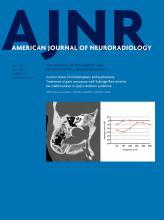Index by author
Jadhav, A.P.
- You have accessReply:A.P. Jadhav, B.K. Menon and M. GoyalAmerican Journal of Neuroradiology May 2018, 39 (5) E58; DOI: https://doi.org/10.3174/ajnr.A5617
Janssen, H.
- EDITOR'S CHOICENeurointerventionOpen AccessEuropean Multicenter Study for the Evaluation of a Dual-Layer Flow-Diverting Stent for Treatment of Wide-Neck Intracranial Aneurysms: The European Flow-Redirection Intraluminal Device StudyM. Killer-Oberpfalzer, N. Kocer, C.J. Griessenauer, H. Janssen, T. Engelhorn, M. Holtmannspötter, J.H. Buhk, T. Finkenzeller, G. Fesl, J. Trenkler, W. Reith, A. Berlis, K. Hausegger, M. Augustin, C. Islak, B. Minnich and M. MöhlenbruchAmerican Journal of Neuroradiology May 2018, 39 (5) 841-847; DOI: https://doi.org/10.3174/ajnr.A5592
Consecutive patients with intracranial aneurysms treated with the FRED between February 2012 and March 2015 were retrospectively reviewed. Complications and adverse events, transient and permanent morbidity, mortality, and occlusion rates were evaluated. A total of 579 aneurysms in 531 patients were treated with the FRED. Seven percent of patients were treated in the acute phase of aneurysm rupture. The median aneurysm size was 7.6 mm and the median neck size 4.5 mm. There was progressive occlusion witnessed with time, with complete occlusion in 18 (20%) aneurysms followed for up to 90 days, 141 (82.5%) for 180 days, 116 (91.3%) for 1 year, and 122 (95.3%) aneurysms followed for more than 1 year. This retrospective study in real-world patients demonstrated the safety and efficacy of the FRED for the treatment of intracranial aneurysms.
Jennings, J.W.
- Spine Imaging and Spine Image-Guided InterventionsYou have accessPercutaneous CT-Guided Biopsies of the Cervical Spine: Technique, Histopathologic and Microbiologic Yield, and Safety at a Single Academic InstitutionE.L. Wiesner, T.J. Hillen, J. Long and J.W. JenningsAmerican Journal of Neuroradiology May 2018, 39 (5) 981-985; DOI: https://doi.org/10.3174/ajnr.A5603
Jeong, E.-A.
- NeurointerventionYou have accessLong-Term Outcomes of Patients with Stent Tips Embedded into Internal Carotid Artery Branches during Aneurysm CoilingS.P. Ban, O.-K. Kwon, S.U. Lee, J.S. Bang, C.W. Oh, H.J. Jeong, M.J. Cho, E.-A. Jeong and T. KimAmerican Journal of Neuroradiology May 2018, 39 (5) 864-868; DOI: https://doi.org/10.3174/ajnr.A5583
Jeong, H.J.
- NeurointerventionYou have accessLong-Term Outcomes of Patients with Stent Tips Embedded into Internal Carotid Artery Branches during Aneurysm CoilingS.P. Ban, O.-K. Kwon, S.U. Lee, J.S. Bang, C.W. Oh, H.J. Jeong, M.J. Cho, E.-A. Jeong and T. KimAmerican Journal of Neuroradiology May 2018, 39 (5) 864-868; DOI: https://doi.org/10.3174/ajnr.A5583
Jia, Z.Y.
- EDITOR'S CHOICEAdult BrainYou have accessLocalized Marked Elongation of the Distal Internal Carotid Artery with or without PHACE Syndrome: Segmental Dolichoectasia of the Distal Internal Carotid ArteryZ.Y. Jia, L.B. Zhao and D.H. LeeAmerican Journal of Neuroradiology May 2018, 39 (5) 817-823; DOI: https://doi.org/10.3174/ajnr.A5573
Intracranial dolichoectasia of the distal ICA was identified in 20 patients from 2005–2016 through a review of diagnostic cerebral angiography results. Images were reviewed to determine the vascular morphologic dispositions around the distal ICA, including dysplasia, mural calcification, vessel wall enhancement, lumen narrowing, and aneurysm formation. In this cohort, which had a strong female predominance (male/female ratio2:18), intracranial dolichoectasia had a more ipsilateral vascular morphologic disposition. Mural calcification was detected more frequently in elderly patients, whereas vessel wall enhancement was detected more frequently in younger patients. Follow-up images showed a slow progression of the lesions. The segmental nature of the striking elongation and tortuosity of the distal ICA suggest a type of congenital lesion representing either a sporadic phenomenon or an arterial change associated with PHACE syndrome.
Johansson, E.
- You have accessInteraction Should Guide Management DecisionsE. Johansson and J. SalzerAmerican Journal of Neuroradiology May 2018, 39 (5) E57; DOI: https://doi.org/10.3174/ajnr.A5579








